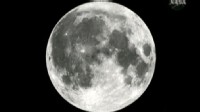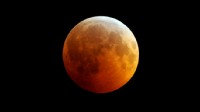Earth Had 2 Moons That Merged, New Theory Says
University of California, Santa Cruz via Nature shows a simulation of a collision between the Moon and a companion moon, four percent of the lunar mass, about 4 billion years ago. (Martin Jutzi and Erik Asphaug/AP Photo)
Share
Comments
Font Sizes
By ENJOLI FRANCIS
Aug. 4, 2011
"Goodnight Moons"?
"The cow jumped over the moons"?
If a new theory published in Wednesday's scientific journal Nature is proved correct, a children's nursery rhyme and bedtime story might need to be revised if not for events in the distant past.
According to scientists at the University of California, Santa Cruz, and the University of Bern in Switzerland, two moons merged in a very slow collision more than 4 billion years ago to create the one that lights up the night sky.
The theory says a collision would explain the vast differences in the lunar landscape. The moon's far side has mountainous highlands while the side facing Earth is low and flat. Though one prevailing idea is that gravitational tidal forces are to blame for the moon's lopsided outer layer, commenters on Nature's website suggested that debris caused many of the moon's craters on its far side.

Vast Amounts of Water Discovered on Moon Watch Video

Lunar Eclipse on the Winter Solstice Watch Video

Do People Act Odd When the Moon Is Full? Watch Video
'Giant Impact' Creates Moon
The scientists' theory expands on a "giant impact" model seeking to explain the moon's creation. Experts believe that an object that crashed into Earth led to debris that later formed the moon. This new theory says the incident also created a smaller, second moon.
According to Nature, planetary scientist Erik Asphaug, from the University of California at Santa Cruz, and Martin Jutzi of the University of Bern, created their own computer model to show how the moon's collision with a second, smaller moon could create its current landscape.
Their theory also says that the slow impact forced most of the smaller moon to attach to the side of the moon as a thick, new layer of the lunar crust.
"They're destined to collide. There's no way out," Asphaug told The Associated Press.





 Reply With Quote
Reply With Quote
Bookmarks